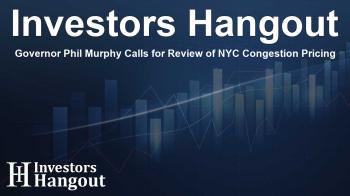Governor Phil Murphy Calls for Review of NYC Congestion Pricing

Governor Murphy's Concerns About NYC's Congestion Pricing
In a recent statement, Governor Phil Murphy of New Jersey voiced his apprehensions regarding the implementation of New York City’s congestion pricing plan. He requested that President Donald Trump reassess the federal approval of this pioneering initiative, which has sparked significant debate since its launch.
The Impact on New Jersey Commuters
Governor Murphy expressed that the congestion pricing program poses serious challenges for commuters traveling from New Jersey to New York City. He labeled the scheme a "disaster," emphasizing that it adversely affects daily transit for countless New Jersey residents who rely on the bridge and tunnel systems.
Understanding the Pricing Structure
Under the new pricing model, commuter vehicles are subject to fees during peak hours, costing $9 for traveling into Manhattan south of 60th Street. For larger vehicles, such as trucks and buses, the charges escalate to a staggering $21.60. However, to mitigate the burden on late-night travelers, the fees drop significantly by 75%, reflecting an effort to balance revenue generation with commuter convenience.
Broader Implications of the Program
The congestion pricing plan not only aims to reduce traffic congestion but also aspires to lower pollution levels in urban areas, promoting a greener environment. Nonetheless, critics argue that it places an unfair load on commuters from neighboring states, particularly those in New Jersey who already face high travel costs and potential traffic delays.
Community Reactions and Future Outlook
Reactions from local communities have varied, with some supporting the initiative for its environmental benefits while others echo Governor Murphy’s concerns about its economic impact. As discussions around the congestion pricing plan continue, stakeholders from both New Jersey and New York are expected to engage in further dialogue to explore solutions that could accommodate the needs of all affected commuters.
Frequently Asked Questions
What is the NYC congestion pricing plan?
The NYC congestion pricing plan is an initiative aimed at reducing traffic congestion and pollution in Manhattan by charging vehicles entering certain areas during peak hours.
How much is the fee for passenger vehicles?
Passenger vehicles are charged $9 during peak periods when entering Manhattan south of 60th Street.
Are there reduced fees for any vehicles?
Yes, fees are reduced by 75% for vehicles entering the area at night.
Why is Governor Murphy concerned?
Governor Murphy believes the program unfairly impacts New Jersey commuters and has called for a federal review of its implications.
What is the purpose of the program?
The primary aim of the program is to alleviate traffic congestion and lower pollution levels in New York City's busiest areas.
About Investors Hangout
Investors Hangout is a leading online stock forum for financial discussion and learning, offering a wide range of free tools and resources. It draws in traders of all levels, who exchange market knowledge, investigate trading tactics, and keep an eye on industry developments in real time. Featuring financial articles, stock message boards, quotes, charts, company profiles, and live news updates. Through cooperative learning and a wealth of informational resources, it helps users from novices creating their first portfolios to experts honing their techniques. Join Investors Hangout today: https://investorshangout.com/
Disclaimer: The content of this article is solely for general informational purposes only; it does not represent legal, financial, or investment advice. Investors Hangout does not offer financial advice; the author is not a licensed financial advisor. Consult a qualified advisor before making any financial or investment decisions based on this article. The author's interpretation of publicly available data presented here; as a result, they should not be taken as advice to purchase, sell, or hold any securities mentioned or any other investments. If any of the material offered here is inaccurate, please contact us for corrections.
